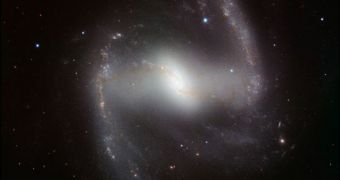Astronomers at the European Southern Observatory (ESO) announce that one of their instruments was just used to snap a new, amazing photo of the barred spiral galaxy designated as NGC 1365.
The experts say that scientists used the HAWK-I camera system for the job. The tool is mounted on the Very Large Telescope (VLT), which is based at the Paranal Observatory, in Chile.
The new image was collected in infrared light, and differs spectacularly from other views of the galaxy, which were collected in visible light wavelengths.
NGC 1365 is one of the most widely studied barred spiral galaxies, and is one with which all astronomers and astronomy students are familiar with.
Experts say that it lied in the Fornax cluster of galaxies, which is located about 60 million light-years away from our planet. The cosmic structure is also known as the Great Barred Spiral Galaxy.
The formation won the right to be called that when scientists first observed its perfect central bar, alongside its two perfectly-outlined spiral arms.
“Closer to the center there is also a second spiral structure and the whole galaxy is laced with delicate dust lanes,” ESO experts say in a press release.
Many astronomers use this galaxy as a cosmic case study of sorts, in the sense that the cosmic structure shows perfectly how spiral galaxies form and evolve.
The new image is bound to make that a lot easier, given that infrared wavelengths can pierce areas of the galaxy that usually remain obscured to telescopes operating in visible light wavelengths.
“These data were acquired to help astronomers understand the complex flow of material within the galaxy and how it affects the reservoirs of gas from which new stars can form,” the experts say.
Stellar nursery appear in this galaxies in areas where the bar distorts or otherwise disturbs the gravitational field that the cosmic structure generates.
When and where this happens, regions of compress gas and dust develop, and this sets the perfect stage for triggering intense stellar formation.
New stars appear when hydrogen gas accumulates inside a massive cloud, that eventually collapses under its own weight into a much smaller volume.
As this happens, the material ignites, producing a proto-star. If enough hydrogen gas existed in the original cloud, then the new star will be able to support nuclear fusion all on its own, and it will survive.
“While the bar of the galaxy consists mainly of older stars long past their prime, many new stars are born in stellar nurseries of gas and dust in the inner spiral close to the nucleus,” the ESO group says.

 14 DAY TRIAL //
14 DAY TRIAL //